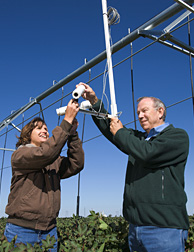Read the
magazine
story to find out more.
|
| 
Agricultural engineers Susan O'Shaughnessy and
Nolan Clark adjust an infrared thermometer that measures crop canopy
temperature as a way of controlling a center pivot irrigation system. Click
the image for more information about it.
|

|
Precision Irrigation Built into Sprinkler Booms
By Don Comis
April 15, 2008 A system that turns irrigation water
on and off automatically based on leaf temperature is being developed by
Agricultural Research Service (ARS) soil
scientist
Steven
Evett and colleagues in Texas.
Evett, a soil scientist at Bushland, Texas, and cooperators are developing
time-temperature threshold (TTT) technology that is based in part on a
discovery by Evett's colleagues at Lubbock, Texas, that plants grow best at
certain narrow temperature ranges that vary by crop species.
Later developments by Evett and his colleagues led to invention of an
irrigation control system that uses feedback from the crop, in terms of leaf
temperatures, to control irrigation and crop water use efficiency.
Evett's colleague Susan
O'Shaughnessy,
an agricultural engineer at the
ARS
Soil and Water Management Research Unit at Bushland, has developed wireless
infrared thermometers mounted on center pivot irrigation arms as well as in the
field. She is also integrating sensors that can help determine whether to skip
watering parts of a field because plants are suffering from disease rather than
drought or because no plants have survived in that part of the field.
Ultimately, she and Evett will seek a cooperative research and development
agreement with a center pivot manufacturing company that can build the sensors
and control system into their equipment.
This research is part of the Ogallala Aquifer Program started in 2004, a
partnership between ARS and the Ogallala region's universities. The Ogallala
Aquifer underlies eight states from Texas to South Dakota and is one of the
world's major aquifers. The goal of the Ogallala Aquifer Program is to protect
the towns and their livelihoods, including agricultural industries, by stopping
the depletion of the aquifer.
Water availability is key to farming in the Ogallala region. Automated
irrigation systems are seen as one major way to move towards sustainable use of
the aquifer because they can reduce water use while enhancing profitability due
to the reduction in pumping costs.
Read
more about the research in the April 2008 issue of Agricultural
Research magazine.
ARS is the U.S. Department of
Agriculture's chief scientific research agency.